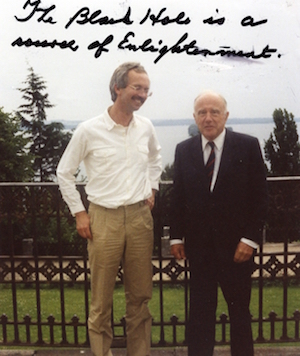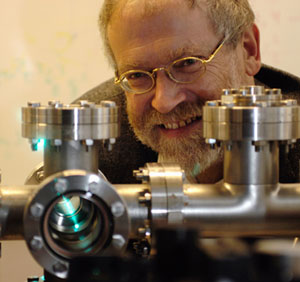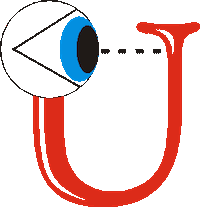If a tree falls in the woods and no one is there to hear it, does it make a sound? Do things only exist if they are perceived? What does physics tell us about reality? These are some of the greatest questions in physics and philosophy, still unanswered after decades, or even centuries, of debate. Some wonder if they can ever be answered, but one physicist was unafraid to try: John Archibald Wheeler.
How come existence?

John Archibald Wheeler (right) with colleague Eckehard W. Mielke (Photo by Emielke – CC BY-SA 3.0)
Wheeler (1911-2008) is a legendary figure in physics. He worked with Niels Bohr to explain nuclear fission, worked on the hydrogen bomb at Los Alamos, and taught many eminent physicists including Richard Feynman, Kip Thorne and Hugh Everett. He was the father of modern general relativity, was key in developing our understanding of black holes and, indeed, popularised the term "black hole" (after it was suggested to him by an audience member at a conference) and coined many others, including "worm hole" and "quantum foam".
Wheeler categorised his long and productive life in physics into three periods: "Everything is Particles", "Everything is Fields", and "Everything is Information". (You can read more about his life and work in his autobiography, Geons, Black Holes and Quantum Foam.) The driving idea behind the third period was spurred by his contemplation of the age-old question: "How come existence?" And his answer, first published in a brilliantly written (and very entertaining) paper in 1989, was it from bit:
"It from bit symbolises the idea that every item of the physical world has at bottom — at a very deep bottom, in most instances — an immaterial source and explanation; that what we call reality arises in the last analysis from the posing of yes-no questions and the registering of equipment-evoked responses; in short, that all things physical are information-theoretic in origin and this is a participatory universe."
No question? No answer!
Wheeler's "it from bit" concept implies that physics, particularly quantum physics, isn't really about reality, but just our best description of what we observe. There is no "quantum world", just the best description we have of how things will appear to us. As Niels Bohr, one of the founders of quantum theory, said:"It is wrong to think that the task of physics is to find out how Nature is. Physics concerns what we can say about Nature."

Anton Zeilinger is Professor of Physics at the University of Vienna. Image: Jaqueline Godany.
Anton Zeilinger, Director of the Institue for Quantum Optics and Quantum Information, explains: "My interpretation [of "it from bit"] is that in order to define reality, one has to take into account the role of information: mainly the fact that whatever we do in science is based on information which we receive by whatever means."
But can we go one step further? Can we say reality is information, that they are one and the same? Zeilinger thinks not: "No, we [need] both concepts. But the distinction between the two is very difficult on a rigorous basis, and maybe that tells us something." Instead, we need to think of reality and information together, with one influencing the other, both remaining consistent with each other.
Perhaps the answer will follow Einstein's great insight from one century ago when he showed that you can't make a distinction between space and time, instead they are instances of a broader concept: spacetime. In a similar way, perhaps we need a new concept that encompasses both reality and information, rather than focusing on distinguishing between them.

Does the act of observing the Universe create it? (Image by David Harrison, University of Toronto)
One clear consequence of "it from bit" is the importance of the observer: reality requires one. "I think [Wheeler] was very radical," says Zeilinger. "He talks about the participatory universe, where the observer is not only passive, but the observer in certain situations makes reality happen."
Before a quantum particle is observed, such as a single particle in a box, it is in superposition, simulatenously being in a number of different locations within the box. All we know (thanks to the solution to Schrodinger's equation for that system) is the probability we'll find the particle in any of these multiple locations. But when we make a measurement, we will find the particle in only one location. Quantum physics doesn't describe reality as it is, but as it is perceived by an observer. It simply can’t answer questions such as "what was the particle doing while no observation was being made?" (You can read more here.)
But Wheeler went further than saying we can only describe reality via our observations. "It's more than that," says Zeilinger. "He would have said that there is no reality beyond what can at least be observed. I don't know whether it's true or not but I like the radicality of this approach."
This idea may be radical but it is not new in philosophy. As far back as 1710, the philosopher George Berkeley wrote "to be means to be perceived". "I don't know whether Wheeler would have gone that far," says Zeilinger. Instead he thinks that Wheeler believed that carefully analysing what information is, and what it means, can teach us about reality.
The shore of our ignorance
"We live on an island surrounded by a sea of ignorance. As our island of knowledge grows, so does the shore of our ignorance." - John Wheeler, From Scientific American (1992), Vol. 267

The double slit experiment: The top picture shows the interference pattern created by waves passing though the slits, the middle picture shows what you'd expect to see when particles are fired through the slits, and the bottom picture shows what actually happens when you fire particles such as electrons through the slits: you get the interference pattern you expect from waves, but the electrons are registered as arriving as particles.
Wheeler's conjecture of "it from bit" has been very important in the development of modern ideas about the role of information in quantum mechanics. It has given theorists, philosophers and experimentalists new avenues to explore questions that have challenged quantum physicists for decades.
The role of the observer is already an area of debate in quantum physics. (You can read more here.) And a participatory universe brings up even more questions, for example: What is an observer? Most physicists agree that an observer doesn't have to be human, or even conscious. Measurement and observations happen in inanimate apparatus: for example, photographic film registers the presence of a photon. But if observations do make reality happen, why do our many observations all agree on one version of the Universe?
If Wheeler is correct and reality is based on answers to yes or no questions, then understanding how these measurements come about is very important. But what is a measurement? This is a straightforward question in classical physics: it is the registering, using some sort of equipment, of what is happening in physical space. The question "Is the object located at point x, yes or no?" has an answer regardless of any observation. But in quantum physics, as we saw above for the example of the quantum particle in a box, measurement is problematic. What happens when we make a measurement, and what constitutes a measurement, is a question that is still open to debate.
But Wheeler suggests that it doesn't make sense to talk of reality before the measurement is made: "The past has no evidence except which is recorded in the present." For example, in the double-slit experiment, whether the standard version or Wheeler's delayed choice experiment, a photon will act as a wave or a particle depending on how you decide to measure it. It doesn't make sense to ask what state it was in before you made the measurement.
And it is not just the theoretical side of quantum physics that has benefited from Wheeler's idea. Zeilinger is primarily an experimentalist and says Wheeler's "it from bit" has had an influence in his and his colleagues' thinking about designing experiments.
"He put out a great challenge for the development of quantum mechanics which is very important," says Zeilinger. "In some points his ideas might turn out to be too radical – it's too early to tell. But that's the process of science! In science it's necessary to have radical positions. And then when these positions are challenged, and we found out how far one can go, then that is progress. It's how science often operates."
About this article
Rachel Thomas is Editor of Plus.
This article is part of our Information about information project, run in collaboration with FQXi.Click here to read other articles related to John Wheeler's concept of "it from bit".
Comments
Great article.
Great article.
Biotechnology
Wheeler’s idea totally revolutionizes the way ordinary people think!
Whose reality?
The most popular interpretation of the Quantum Enigma (Copenhagen) posits that a particle becomes "real" only when observed. This brings to mind a question that can be best expressed by an analogy to the macro world. During the War of 1812 the Battle of New Orleans was fought some time after a peace treaty had been signed. The combatants were unaware that the war had ended because of the communication delay. The war was simultaneously over and still in progress. The question this poses to quantum theory is would a particle that has been observed (waveform collapsed) appear real to a subsequent observer?
according to wheeler...
“we are participants in bringing into being not only the near and here, but the far away and long ago.” so what does that tell you about the civil war? "a pre-life Earth would have existed in an undetermined state, and a pre-life universe could only exist retroactively.". wheeler has proven every bizarre claim he has made, wheelers delayed choice proves P.A.P, and it from bit. he did not design that experiment for giggles.
Like shakeing a dice in a jar..
...and wondering why it doesn't show a number before stopping the dice. I think it's time for physics to face the fact, that some characterisics doesn't exist all the time. But I won't go so far to say there is no reality beyond that, because the dice exists.
Quantum
I have been trying to get a general idea of what can collapse the field into a defined reality for awhile now, I see a lot of information but most of it does not address my wonderings on the subject very well. I have wondered if a bug were placed as a detector (bug consciousness, yet consciousness) whether that is enough to collapse the wave to produce a two bar pattern in the double slit experiment and after reading this article, it appears possible, that any kind of measurement will do that. So, what are the implications of that?
Quantifying ignorance
As a kid around 12, I came across a statement , attributed to an Arabic scholar of mideaval times , as i recall that mirrors Wheel's metaphor of the island . "The greater the diameter of light, the greater the circumference of darkness ". I wonder , in the presumed singularity before the Big Bang, " what observed what ? ", put differently,
if Entropy = 1, is there anything at all ?, so out of nothing something comes ??? Fun craziness to play with on a snowy day .
Wheeler - yes. Zeilinger no.
Every quote from Wheeler in the article resonates as truth. Then Zeilinger attempts to put words in his mouth and the result is discordant noise.
"I think [Wheeler] was very radical, He talks about the participatory universe, where the observer is not only passive, but the observer in certain situations makes reality happen." - no. Wheeler never said that reality does not exist without observers.
And most distasteful:
"But Wheeler went further than saying we can only describe reality via our observations. "It's more than that," says Zeilinger. "He would have said that there is no reality beyond what can at least be observed. I don't know whether it's true or not but I like the radicality of this approach."
No, Wheeler would not have said that. He said there is no *evidence* beyond what can be observed. We can make no statements about reality without observable evidence, but reality exists regardless.
Thank you David9
Thank you for bringing some clarity and sanity to bear on this ridiculously solipsistic discussion.
It from bit: continuum vs. discrete
I was fortunate to meet John Wheeler when he visited my university to talk about Black Holes in the mid ‘70s just before he went to UT Austin.
I asked him a question that gave him pause… he stumbled backwards.
I asked him if he had questioned his fundamental assumptions, such as is time discrete or is it continuous.
He did not answer at that time, but years later he coined “It from Bit,” which seems based on that question.
My followup question if he answered discrete would have been “Is there a shortest unit of time?” which is implied if time is discrete. If yes, my next question would have been “What exists between those shortest units of time?”
This question has haunted me ever since I met Dr. Wheeler. Have these questions ever been posed and considered?
Opportunity pre-exists everything
Hi Ralph Harnden,
Ideologically, logically, Opportunity must pre-exist the becoming of all things. If the context of that thing coming into being, its opportunity for being, does not exists, then that thing cannot become a reality. Opportunity sits between it all.
Time is a relative measure of change; an idea that helps humans order and understand reality. You set the length of time to more clearly represent the material change under study. -g
Great article
For me, it’s a vast cybernetic system which I am both participant and the participated. Long ago when first learning Photoshop I dreamed I was both the observer zooming onto a pixel, and the pixel itself. The idea information generates physical reality also recalls Plato.
Information theory is between physics and math in xkcd 435
Cited from https://en.wikipedia.org/wiki/Entropy_(information_theory) : "in the view of (Edwin Thompson) Jaynes (1957), thermodynamic entropy, as explained by statistical mechanics, should be seen as an application of Shannon's information theory: the thermodynamic entropy is interpreted as being proportional to the amount of further Shannon information needed to define the detailed microscopic state of the system, that remains uncommunicated by a description solely in terms of the macroscopic variables of classical thermodynamics, with the constant of proportionality being just the Boltzmann constant."
I find this quite appealing. Considering that "bit" in information theory is unitless, it's just number, this hypothesis may be true. And with this model, we may be able to unify physics and computation in the future[0][1].
We can view current physical laws as constrains applied to the logical world of "bits". Each law gives a set of more constrains on how the world(particles, wave, or any other physical representations) should behave. Our world may be just one of many possible worlds described by math.
[0]: https://en.wikipedia.org/wiki/Limits_of_computation
[1]: https://physics.stackexchange.com/questions/403016/is-there-a-physical-…
Truth and Reality
Hi
Thank you for this fruitful article. Zeilinger has accurately commented and reflected on Wheeler's view on the "Reality". However there are plenty of rooms to be discussed on the "Truth" an Wheeler's view on that.
Bests